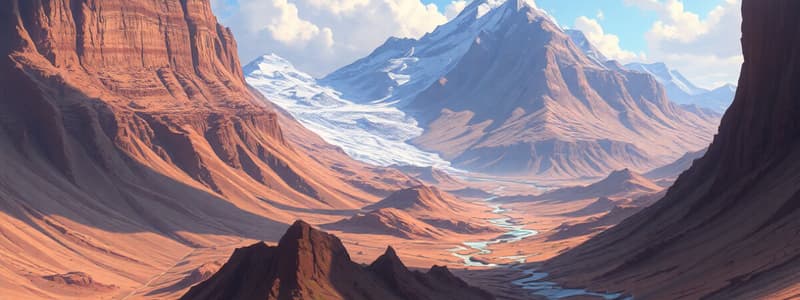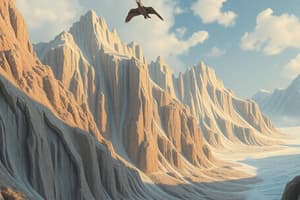Podcast
Questions and Answers
How do glaciers contribute to erosion?
How do glaciers contribute to erosion?
- By creating sand dunes.
- By creating thermal columns that melt the surrounding permafrost.
- By transporting and grinding rocks against the ground, scraping away soil. (correct)
- By depositing layers of sediment that protect the underlying rock.
What is the primary process behind thermal erosion?
What is the primary process behind thermal erosion?
- The thawing and disintegration of permafrost due to warmer temperatures. (correct)
- The mechanical breakdown of rock due to wind.
- The grinding action of glaciers on coastal rock formations.
- The chemical weathering of coastal cliffs by seawater.
Which of the following best describes a coastline?
Which of the following best describes a coastline?
- A zone characterized solely by rocky cliffs and headlands.
- A region exclusively composed of sandy beaches and dunes.
- The boundary where land meets the sea, including beaches, cliffs, and estuaries. (correct)
- The specific area where glaciers meet the ocean.
How does wind contribute to the erosion and shaping of landscapes?
How does wind contribute to the erosion and shaping of landscapes?
How do waves, tides, and currents interact to shape coastlines?
How do waves, tides, and currents interact to shape coastlines?
What is a characteristic of coastlines made of granite?
What is a characteristic of coastlines made of granite?
How do tides influence sediment deposition on coastlines?
How do tides influence sediment deposition on coastlines?
How do the wave's energy levels affect the movement of sediment and rock particles along coastlines?
How do the wave's energy levels affect the movement of sediment and rock particles along coastlines?
What is the appearance of the coastline with small, narrow beaches?
What is the appearance of the coastline with small, narrow beaches?
How can coasts help us understand natural events?
How can coasts help us understand natural events?
How does pollution affect coastlines?
How does pollution affect coastlines?
How do glaciers transform landscapes?
How do glaciers transform landscapes?
If a location has a large tidal range, what effect does this have on sediment deposition?
If a location has a large tidal range, what effect does this have on sediment deposition?
Where are glaciers found?
Where are glaciers found?
What is a tombolo?
What is a tombolo?
Flashcards
What is a coastline?
What is a coastline?
The boundary where land meets water, including beaches, cliffs, and estuaries.
Erosion by Ice
Erosion by Ice
Erosion caused by ice, usually in the form of glaciers, which scrape and grind rocks as they move.
Thermal Erosion
Thermal Erosion
Erosion of permafrost along a river or coastline due to increasing temperatures, causing chunks of coastline to break off.
Headland
Headland
Signup and view all the flashcards
Tombolo
Tombolo
Signup and view all the flashcards
Beach
Beach
Signup and view all the flashcards
Dune
Dune
Signup and view all the flashcards
Cave
Cave
Signup and view all the flashcards
Lagoon
Lagoon
Signup and view all the flashcards
River Estuary
River Estuary
Signup and view all the flashcards
Stack
Stack
Signup and view all the flashcards
Natural Arch
Natural Arch
Signup and view all the flashcards
Rocky Islet
Rocky Islet
Signup and view all the flashcards
Spit
Spit
Signup and view all the flashcards
Cliff
Cliff
Signup and view all the flashcards
Study Notes
- Waves and wind move sand and small bits of the Earth.
- Wind forms sand dunes, changing their shape and blowing soil off farmland.
- Wind-carried sand and soil slowly change the shape of rocks.
Erosion by Ice
- Ice, mainly in glaciers, erodes the earth, creating landforms.
- Glaciers move downhill in cold areas and mountaintops.
- They transport everything, from tiny grains to giant boulders.
- Rocks carried by glaciers scrape the ground, eroding both the ground and rocks.
- Glaciers grind rocks and scrape away soil.
Thermal Erosion
- Thermal erosion affects permafrost along rivers or coastlines.
- Warm temperatures cause ice-rich permafrost to break off coastlines in huge chunks.
- Topsoil and vegetation are also carried with the ice.
- These eroded "floating islands" can disintegrate in the ocean or crash into other land.
- This disintegration assists the growth of life in different landscapes.
Coastlines
- A coastline marks where land meets sea (oceans).
- Coastlines have beaches, cliffs, capes, caves, bays, and estuaries.
Coastal Features
- Beach: An accumulation of sand or pebbles along the coast.
- Cliff: A steep rock face shaped by the sea.
- Cave: Natural underground cavity formed by water slowly dissolving and eroding rock.
- Dune: Accumulation of sand shaped by the wind.
- Headland: Tapering strip of land jutting into the sea.
- Lagoon: Shallow expanse of seawater separated from the sea by a sand ridge or barrier island.
- Natural Arch: Arch hollowed out of a headland by the sea.
- River Estuary: Formed by the mouth of a river that is influenced by the tides; the indentation in the coastline varies in width and depth.
- Rocky Islet: Small island made of rock.
- Skerry: A small rocky island.
- Spit: Elongated ridge of sand or pebbles extending into the water.
- Stack: Needle-shaped column resulting from the collapse of an arch.
- Tombolo: Ridge of sand that joins an island to the shoreline.
Coastlines
- The coast is the land along a sea; the boundary between land and water is the coastline.
- Waves, tides, and currents shape coastlines.
- Eroding water wears away at the land.
- Little parts of the sea like shells, sand dollars, seaweeds, and hermit crabs remain.
- Hard materials like granite make coasts stable for centuries.
- Tides (ocean rise and fall) deposit sediment on the coast.
- Large tidal ranges are where waves deposit shells and hermit crabs further inland.
- Small tidal ranges see smaller waves that place material closer to shore.
- High energy in larger waves move more sediment.
- Larger beaches allow waves to spread their energy and deposits.
- Smaller, narrow beaches concentrate wave energy, making them look tattered and weathered; sandy beaches are washed away, and rocky coastlines are cracked by strong waves.
Changing Coastlines
- Coasts indicate natural events like weather and changing sea levels.
- Coasts are the first to flood during storms.
- Some coasts have coastal plains (flat, low-lying land visible when sea levels drop).
- Coasts can be rough due to pollution, oil spills, and garbage.
- Pollution affects their appearance.
- Pollution damages marine life.
Studying That Suits You
Use AI to generate personalized quizzes and flashcards to suit your learning preferences.




